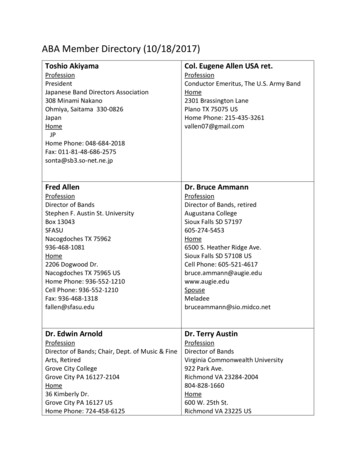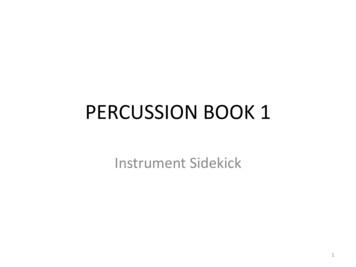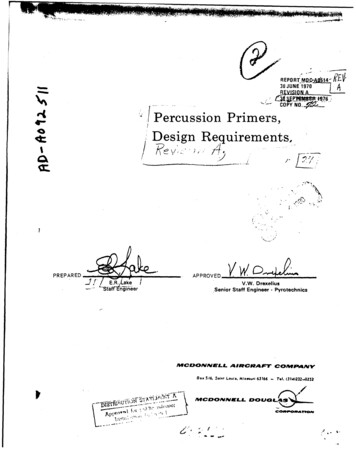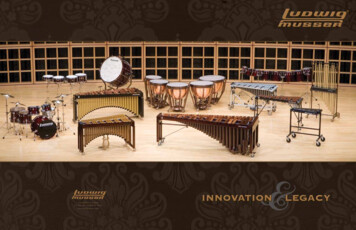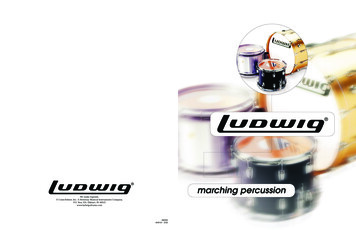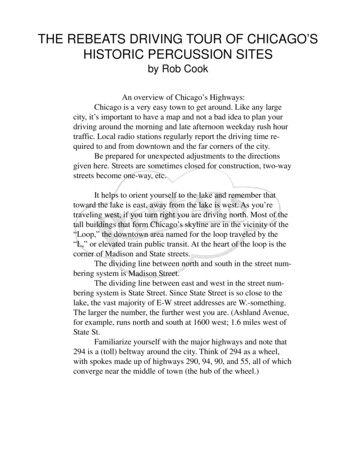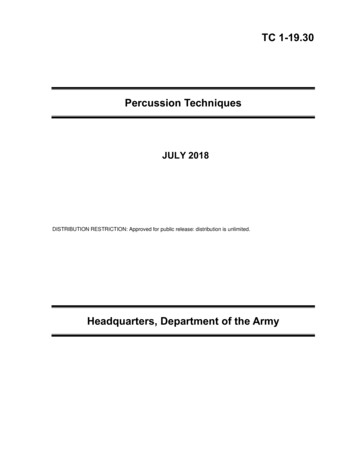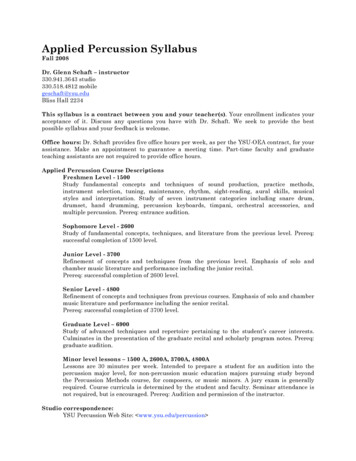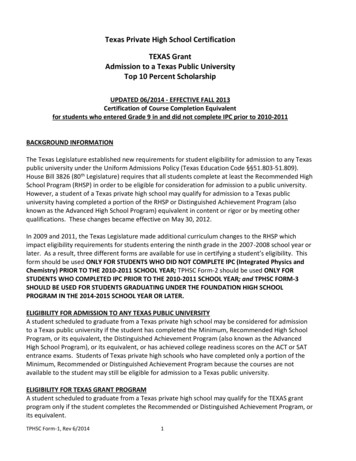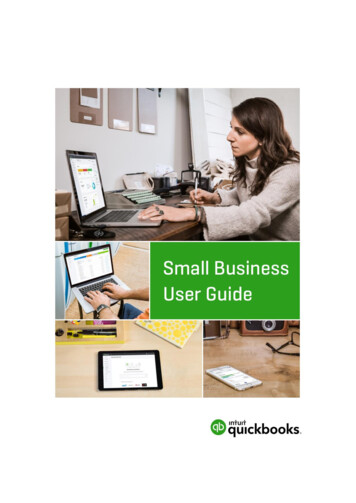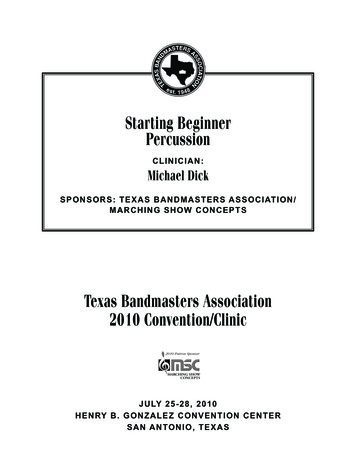
Transcription
Starting BeginnerPercussionClini c ian:Michael DickS p o ns o r s : TEXAS B AN DM A STER S ASSOC IATION/m a r chi ng show concept sTexas Bandmasters Association2010 Convention/Clinic2010 Patron SponsorMARCHING SHOWCONCEPTSj u ly 2 5 - 2 8 , 2 0 1 0H e n ry B . G o n zalez Convention CenterS a n Antonio, Texas
Starting Beginner PercussionTexas Bandmasters Association ConventionJuly 26, 2010, Room CC206Clinician: Michael DickDirector of Bands, Cook Middle School, Cypress-Fairbanks ISDmichael.dick@cfisd.netChoosing the Beginning PercussionistI like to start approximately 12 beginning percussionists a year. By starting this many, youcan make sure there are plenty to outfit 2-3 MS/JH Bands and send 6-8 to high school everyyear.Make sure that from the beginning the students and parents understand that this is not a“drum” class. Be up front with them so they know what they are actually getting into –learning snare drum, keyboards, timpani, accessories, etc.I use the following rhythm/coordination test to choose my percussionists: Sit in a chair and face me Turn a metronome on 72 with quarter notes Have the students tap their right foot with you mirroring (left foot) While tapping the foot, clap your hands with the beat They will probably get this – ask them is it easy, which directions did your foot go,what part of the beat were you clapping on, etc. Then have them tap their foot and clap on the up-beat (this will show a lot) Clap/Count Procedureo In 4/4 timeo Clap/Count Random You count 1,2,3,4 Clap on 1,2,3 or 4 – change this upo Clap/Count Sequential You count 1,2,3,4 Clap on 1 in 1st measure, 2 in 2nd measure, 3 in 3rd measure and 4 in4th measure This makes them think! Have them tap their right foot, then tap their right leg, then add tapping their left legin an alternating motion in eighth notes (right, left, right, left, etc.) Go to a table and play some simple-to-hard rhythms for them to play back to you Have them sing/hum a couple of pitches to you (F, Bb)I also prefer students with piano background (though not required). Piano backgroundusually helps the students grasp the concepts more quickly.General OverviewI like to spend a majority of the year (around 60%) on practice pad. I believe that properdevelopment on the practice pad sets the basis for all playing on percussion. On the practicepad, you are able to develop the correct grip and wrist stroke that is needed to play mostpercussion instruments. Once the student has correctly developed this stroke, you can thenapply it to keyboards and timpani.I begin the school year by spending several weeks on the practice pad. Through these firstseveral weeks, I am able to develop the stroke through single-handed exercises, stick controlpatterns, and sixteenth note exercises. I also begin doing reading of simple rhythms (quarternotes and eighth notes) during this time. I introduce all exercises in a very simple form. InTEXAS BANDMASTERS ASSOCIATION CONVENTION/CLINIC 2010
the past, as the first semester progresses, I make these exercises more advanced to challengethe students. For example, I take a double beat exercise and start by teaching it in quarternotes. Once the students understand this, then I change it to eighth notes. After theyunderstand the eighth notes, I change it to sixteenth notes.I would also suggest spending parts of the first few weeks showing them the various thingsthey need to know about percussion .where all the equipment goes, always cover theinstruments when you are finished playing, how to take care of their instrument, labelingtheir equipment, etc. By doing lots of “things” during class, the students feel like they areaccomplishing a lot!I begin keyboards around the beginning of the 2nd Six-Weeks. I would spend a 2-4 weeks onkeyboards, and then review practice pad before getting to the Winter Concert music. As theyneed, intersperse days of timpani or accessories that they will need to know for the upcomingconcerts/performances.Equipment Remo Practice Pad and Stand (brought back and forth everyday)o Practice Pad vs. Snare Drum Practice Pad is transportable so they play on the same instrument in classand at home Practice Pad is more affordable Practice Pad is a lot softer At home for mom and dad At school with 8-12 “drummers” in classo Practice Pad Stand All students need to purchase a practice pad stand. Having the practicepad stand allows them to practice with the same setup and grip that youhave taught them during class. I like for students to bring their practice pad stand to school each day.The stand does fit inside the large stick bags with the top sticking out ofthe bag. If you have enough snare drum stands at your school, you canhave the students keep their stand at home and use the school standsduring class.Keyboard Instrumento Practice Keyboards – these are great and will last through high school, but areexpensive. You will need to have enough keyboard instruments at school for yourstudents to play on during class. Cadence Practice Marimba – C600 Ross Practice Marimba – R409 Musser Practice Xylophone – M41o Bell Kit These are cheaper and work fine, but are not as realistic as the practicekeyboard. If you do not have enough keyboard instruments at your school forstudents to use during class, have them obtain a bell set and they can takeit back and forth from home and school.Innovative Stick Bago This is a large bag that the practice pad will fit easily intoInnovative IP-LD Snare Drum Sticks*Mike Balter 04R Light Green Rubber Malletso I like the rattan handles as they do not break as easily*Mike Balter 23R Blue Cord Mallets*Vic Firth T3 Staccato Timpani MalletsSnare Drum BookTEXAS BANDMASTERS ASSOCIATION CONVENTION/CLINIC 2010
o Simple Steps to Successful Snare Drumming – Keenan Wylieo A Fresh Approach to Snare Drum – Mark WesselsMallet Booko Simple Steps to Mallets and Other Percussion – Keenan Wylieo A Fresh Approach to Mallet Percussion – Mark WesselsPocket MetronomeFolder for any exercises/music I hand outPencil***Always keep keyboard and timpani mallets in the plastic bags they come in so themallets last longerClassroom Setup Try to have a class that is only beginning percussion. Beginning Percussionists need aclass to themselves because there are so many special things they need to be taught thatdo not relate to the beginning woodwind/brass classesI have the students stand in a semi-circle. This way I can stand in the middle of the circleand can easily view and assess all students. Students are also very easily able to see anydemonstrations I need to makePractice Pad Proper Setupo The pad should be approximately 1-2 inches below the student’s waist. You willwant to check with each individual student to make sure their elbows are not inor out too much.o Make sure the legs at the bottom are spread out correctly mainly look for notspread out enoughProper Gripo Steps to the Proper Snare Drum Grip Sticks should be at a 90 degree angle Sticks should be approximately one inch apart and one inch off the top ofthe drum head “Windows” Closed Wrists Flat (should be able to keep a quarter on top) See the butt ends of the stick out of the corner of your eye Fulcrum should be firm Fingers around the stick No gaps in the fingers***If you do all these things correctly, the stick should move straight up anddown.Leverso Lever 1 – Arm – Only a day or two at the beginning – they will use this later forbuzz rollso Lever 2 – Wrist – This is what they will use once you teach it for the rest of theyear. Teach this in a down/up pattern so they begin feeling the subdivision – liftup on the & or te and down on the downbeato Lever 3 – Finger – for very high level playing (rarely used in middle school)Exerciseso *Do all exercises with a “right hand lead”. This is what we will begin mostpractice pad/snare drum pieces with. However, once students becomecomfortable with the various exercises, it is a good idea to do a “left hand lead”to help the students become more comfortable with the left hand and notcompletely dependent on the right hando Eight on a Hando 8s and 16so Single-Beat Combinations/Stick Control (Lesson 1in your book)TEXAS BANDMASTERS ASSOCIATION CONVENTION/CLINIC 2010
Double BeatUpstroke/Downstroke ExerciseDouble-Bounces As you speed up the Double Beat exercise, this leads into the DoubleBounce. Begin by teaching the double-bounce in each hand separately Squeeze the fulcrum firmer Let the back fingers relax and come off the stick a little Use a combination of Lever 1 and 2 Lift with your arm, and drop into a double stroke/bounce – makesure there are only 2 Bounces! Diddles Exercise Chicken and a Roll Exerciseo Buzz Rolls Begin by teaching the buzz in each hand separately Squeeze your fulcrum firmer Let the back fingers relax and come off the stick a little Use Lever 1 (arm) Lift with your arm, and press down into the pad Let the stick vibrate for as long as possible Single-Handed Buzz Exercise Once you have mastered the single-hand buzz, then move to slowlyalternating back and forth. Start with slow alternating and then speed upuntil a smooth and calm buzz roll is achieved Buzz Roll Exercise Students will need to build into a 16th note roll baseo Rudiments – Learn these in groups of 8 Paradiddles Double Paradiddles Triple Paradiddles Paradiddle-diddles Flams Flam Accents Flamadiddles Flam Taps Ruff 5-Stroke Roll 7-Stroke Roll 9-Stroke Roll 13-Stroke Roll 17-Stroke RollLines out the Book/Soloso I would suggest working on lines out of the book that correspond with whatfundamentals you are teachingo Try to do at least one line out of the book each dayAfter Spring Break, I would hand out some easy solos to give them some differentliteratureo Rudimental Cookbook – Edward Freytag There are several solos at the beginning of the book that students canlearn quicklyo Shazaam – John Pollard This book has simple, yet “cool-sounding” solos that students will loveplaying!ooo TEXAS BANDMASTERS ASSOCIATION CONVENTION/CLINIC 2010
Keyboards When do I start keyboards?o I like to start keyboards around the beginning of the second six-weeks or whenthey start to get bored with the practice pado The stroke is a fluid stroke while trying to achieve even stick heights – this is thesame thing we address when playing the practice padScales/Patternso Students should know at least the Region Band Tryout scales for your region – ifyou have time, do not hesitate to learn all 12 Major Scaleso If there is time, I would suggest learning the Green Pattern, Thirds and Arpeggiosbecause that will enhance their musical knowledge and they will be able to playmore advanced literature easier and quickero Learn the Chromatic Scale – Two Octaves – C-C or F-F – teach them what theyneed to know for Region Band Tryouts I like starting with the left hand and alternating while trying to achieve asmooth motionRollso Single-Stroke Rollso Have them play straight sixteenth notes, then just relax their hands/fingers andspeed their hands up a littleReadingo Students should be able to read music without writing in note nameso Students should be able to play a new piece of music while looking at the musicand not looking at the keyboardo Start by reading pieces with just 2-3 notes, and start reading pieces that graduallyadd more notes4-Malletso I use the Stevens Gripo It is a good thing to show the kids how to hold 4-mallets at the end of the year.This way they can begin working on the proper technique in 7th gradeo Bring in a percussionist to teach and demonstrate this skillTimpani Amount of instruction timeo I do not spend a lot of time on timpani – I feel they just need to know the“basics” of playing timpanio They need to know the proper up-stroke Teach the students to use an up-stroke because you want them to pull thesound out of the drum. Keep your wrist down and close to the drum andkeep the head of the mallet about nine inches above the head – do aquick wrist stroke to strike the drum and quickly bring the mallet back towhere you started while keeping the wrist down This up-stroke will give you a clearer, more resonant sound. Using adownstroke or pounding will give you a much harsher and duller soundo They need to know the proper playing zones (2-3 inches from the edge betweenthe lugs)o Teach them the sizes (32, 29, 26, 23 – moves by 3 inches)Gripo American Grip (what I use in MS/JH) Same as the matched grip for snare drumo French Grip Thumb is facing directly up. I do not teach this in MS/JHSample Exercises/Songso I like to have students do an 8s and 16s exercise on timpani to work the propertimpani stroke – the sixteenths build into the “roll”TEXAS BANDMASTERS ASSOCIATION CONVENTION/CLINIC 2010
oAny songs out of your method book or the Modern Method for Timpani by SaulGoodman that are 2-3 drums with simple rhythms (quarter, eighth and basicsixteenth) Rollsoo Tuningo Have the students sing pitches you play on a keyboard instrument – you can evenstart this at the beginning of the year while they are still real excited – then as theyear progresses, they don’t think singing is weirdo Once they can sing a pitch, they can try to tune the timpanio Start with the pedal to the floor, have the pitch in your head, tap the drum with amallet and slowly glissando up to the pitcho You can even have the students sing the pitch, and while you glissando up, havethem raise their hand when they think you get to the correct pitchMoving the Timpanio Students need to know the proper way to transport timpani from one place orroom to another. They need to grab the timpani by the legs opposite the pedal,place one foot on the bottom dome of the timpani, and pull the timpani back ontothe wheels for easier transport. Single-Stroke RollsHave them play straight sixteenth notes, then just relax their hands/fingers andspeed up a littleAccessories Bass Drumo Tilt the bass drum at a 30-45 degree angle to the flooro Play on the higher pitched heado Place your left hand on the top of the batter head and press lightly to dampen theexcess ringo Play with the mallet in your right hand, and use no more than a 2-inch stickheight either right above or below the center of the heado Rolls: use two identical bass drum roller mallets and play at a 180 degree angleabout 4-6 inches from the edges of the drum Use a single stroke rollCrash Cymbalso Do not put your hands through the straps – this is only for marching band!o Hold one cymbal in your left hand at a 30-45 degree angle and hold it still (thinkof it as a table)o You will do all work with the right hand: lift and drop into the left hand cymbalwith a flam motion – this allows any air collected to escape out either side of thecymbalso For the flam motion, you can hit the bottom or top first – your preference – thenbring the top cymbal back up to allow for as much ringing and resonance aspossibleSuspended Cymbalo Play all single notes with your mallets at a 180 degree angle, and strike bothmallets at the same time with an upstrokeo Rolls are single-stroke at a 180 degree angle – start rolling at 1 inch and thengrow to 4-6 inches depending on the dynamic level of the musico Ride Cymbal Music – play with a snare drum stick about 1-2 inches from theedgeTriangleo Have your left hand form a “C” and let the clip rest on top of the “C”o Hold the beater with two fingers and a thumb in your right hand and play at a 45degree angle to the triangle in the bottom right cornero The opening of the triangle should go to your lefto Hold the triangle high enough so you can look through the triangle at theconductorTEXAS BANDMASTERS ASSOCIATION CONVENTION/CLINIC 2010
Rolls can be done at the top or bottom rounded corner of the triangle by strikingboth sides of the triangle in an even back-and-forth motionTambourineo Hold the tambourine in your left hand where there are no jingles with the headfacing upo Hold it up at a 45 degree angleo Use your right hand to strike the tambourine Soft Playing – use two or three fingers to tap the edge of the tambourine Medium Playing – bunch your fingers together and use a wrist stroke totap the tambourine Loud Playing – Use a fist and play with an arm motiono Rolls – Have them learn a shake roll by rotating the tambourine at a slight angleback and forth as quick as possible with a good sound. Have the students try theshake roll in each hand and see which one is bettero Band Music SetupoIf the percussion are in the back, use this order from left-to-right: Timpani, BassDrum, Snare Drums, Accessories, Keyboardso If the percussion are on either side, use this order from front-to-back:Keyboards, Bass Drum, Snare Drums, Timpani, Accessories behind the BassDrum and Snare DrumsDistribution of Partso For three band pieces, I try to have each student play snare drum, mallets, andone accessory parto I typically use no more than 4 snare drummers and 4 mallet players in a singlepieceo Always put a strong person on snare drum and a strong person on mallets to leadthe other studentsRewriting/Adding Partso Feel free to rewrite or add parts to make the music more interesting to play.Many times beginning band percussion parts are very easy and boring, andrewriting or adding parts can keep the students more interested and engagedo I would suggest adding additional accessory parts, congas, bongos and/or tomtoms and timpaniEnsemble Skillso Because the band music is easy, you can use this time to begin teaching ensembleskills while playing with the band Watch the conductor every 1-2 measures Listen to who has the melody and not play louder than them Play “tastefully”Ensemble Music I think that beginning percussionists should learn and perform 2-3 percussion ensembles.They will think it is extremely cool to play a piece on the concert by themselves! Thereare many great easy pieces that are fun to learn that get the students excitedEnsembles I useo Jingle Bells by Mark Wesselso William Tell Overture arranged by Keenan Wylieo Parade of the Wooden Soldiers – Leon Jessel/John Willmartho Other good ensembles: Oriental Mambo by Thomas Brown Other easy ensembles arranged by Keenan Wylie Rhythmsicles by Row-Loff Productions Groovesicles by Row-Loff Productions Orientale by O’ConnorTEXAS BANDMASTERS ASSOCIATION CONVENTION/CLINIC 2010
Various Tips Try to play at least one line/song out of the book each day – they will feel like they aremoving forward more quickly than they actually are.Have a 6th Grade Solo and Ensemble Contest at the end of the year to get feedback onwhat they have learned and motivate them to stick with it by earning a ribbon or medal.School or Cluster Percussion ConcertPrivate Lessons – these should be highly recommended due to the large number ofinstruments and techniques the students need to know. While the band director isworking on one skill, the private lesson teacher can either work on that skill or continuehelping the student master previously taught skills.Don’t hesitate to bring in actual percussionists to demonstrate or teach new techniques oraccessories.Give the students various websites of percussion manufacturers as they have manypodcasts and videos demonstrating cool percussion stuff!Promote your high school marching band and DCI. These are additional venues thatexcite percussionists!TEXAS BANDMASTERS ASSOCIATION CONVENTION/CLINIC 2010
Year at a GlanceFirst Six-Weeks Music TheoryoApproximately Two WeeksoBegin interspersing things such as howto hold the stick, how to set up the pad,labeling equipment, etc. to help thetime go by faster Practice PadoLever 1oLever 2oExercises 4/8 on a Hand 8s and 16s Single BeatCombinations/StickControl (Lesson 1 in yourbook) Sixteenth Note TimingPatterns (Begin withQuarter Note, then move toEighth Note) Upstroke/DownstrokeExercise Double Beat (Begin withQuarter Note, then move toEighth Note)oBegin reading simple rhythms (quarternotes, eighth notes)Second Six-Weeks
o Steps to the Proper Snare Drum Grip Sticks should be at a 90 degree angle Sticks should be approximately one inch apart and one inch off the top of the drum head “Windows” Closed Wrists Flat (should be able to keep a quarter on top) See the butt ends of the s
